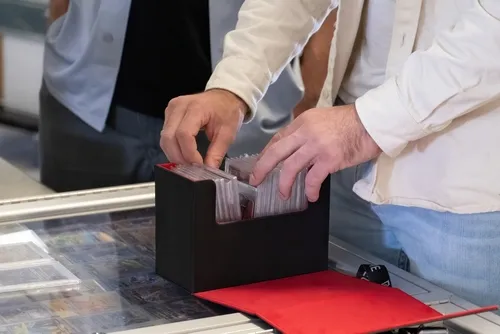Storage Guide for Collectible Trading Cards

According to market research, the trading card market was worth $1.67 billion in 2023 and is estimated to grow to $2.34 billion by 3032. But, before you go digging through your parent's basement searching for that lost box of Pokémon or NFL cards, take a moment to read these tips for safely storing your rectangular treasures.
And don't forget to check out our other Collectible Guides for:
Types of Storage
Thousands of trading card collections are wrapped in old rubber bands and stuffed in a shoebox in attics and basements across the globe. While this was the perfect storage solution when you were a kid, you need to invest in some proper storage for your collection to maintain any value.
Cardboard Boxes
For a budget storage option that favors quantity over quality, it's hard to beat cardboard boxes. But don't just use any old shoebox from around the house. Those boxes aren't sized for collectible trading cards. Cards left loose in a wrong-sized container can easily become bent or torn when moved around.
Instead, consider purchasing trading card boxes from a trading card dealer or supply store. Sized to comfortably fit your cards and keep them from moving around, these boxes are available in a range of sizes that can fit anywhere from 100 to 500+ cards. Be mindful, however, that bulk storage makes finding specific cards more difficult. If you have multiple collections or sets, don't forget to label them clearly!
Albums & Pocket Pages
If you want to make it easier to find specific cards or browse your collection more quickly, try plastic sheets that can be kept in a binder or album. Also called "pocket pages," these clear plastic sheets hold up to nine cards each, 18 if you use the back and the front. They are slightly more expensive than boxes but still a budget-friendly way to store your collection.
Make sure to get archival polyester (PET), polypropylene or polyethylene plastic and avoid PVC (polyvinyl chloride), as this type of plastic can damage your trading cards.
Sleeves & Toploaders
For individual card protection, sleeves and toploaders are the go-to options. Both are plastic holders sized slightly larger than a standard trading card that protect your cards against scratches and general wear and tear. Toploaders are typically used for more valuable cards and are made of thicker plastic for extra protection against bending. As with any plastic trading card storage, opt for an option that does not use PVC.
Card Holders
For your most valuable and treasured cards, like signed cards or limited-release items, try card holders. Unlike sleeves and sheets, which typically have an open side for quick and easy removal, card cases are designed to keep your card completely sealed. They come in several styles, including magnetic, snap seal or even screw-down varieties. Some even advertise as protecting against mold and mildew, which can be disastrous for paper products.
However, these cases are heavier and bulkier than other storage options and can quickly eat up your space. You could also argue that if they are valuable enough to store in a heavy-duty case, you may want to store them in your home or a safe box instead. High-value and irreplaceable items are not recommended for self-storage.
Storage Location
Storage boxes and sleeves help protect your cards from bending and wear and tear, but you still need to consider the environment in which you store them. The two biggest threats to your collectible trading cards are direct sunlight and moisture. Exposure to sunlight over time will cause your cards to bleach and fade. Moisture can cause paper to warp and deteriorate while also encouraging mold growth.
Avoid storing your card collection in uninsulated areas of your home, such as attics, garages and basements. These areas are prone to changes in temperature, which can affect moisture and humidity levels and lead to damage. They are also more prone to pests. Mice and certain kinds of insects will use paper to make their nests.
If you want to store your cards at home, keep them in a closet or on shelves inside your home, where temperatures and the overall environment remain stable.
If your collection has outgrown your home or you want to make some extra room, one option is a climate-controlled self-storage unit. Similar to your home, climate-controlled storage units have HVAC systems that keep the space warm in winter and cool in the summer, protecting your belongings from the dangers of fluctuating temperatures.
Looking for something a little smaller? Storage Post has lockers for rent, too!
See: 5 Reasons You Should Consider Climate-Controlled Self-Storage.
The Do's and Don'ts of Collectible Trading Card Storage
The Do's
- Use proper storage materials such as trading card boxes, plastic sleeves, albums and hard cases
- Label your containers and keep an inventory of your cards, including which box has which cards
- Get the rare items in your collection appraised and consider storing your most valuable items at home or in a safety deposit box
The Don'ts
- Store loose cards in containers; they can get bent or damaged by sliding around.
- Keep your collection in places that experience temperature swings, such as attics or basements
- Let your cards receive direct sunlight, as this will cause fading
Trading cards have been a favorite type of memorabilia for fans and collectors alike for decades. Whether you're storing a potential investment, childhood memories, or a combination of both, Storage Post has you covered. Our facilities offer a wide range of self-storage options with premium amenities to bring you a storage experience that is safe, easy and convenient.
Up To Two Months Free!
For a limited time, get up to two months rent free* on selected units.